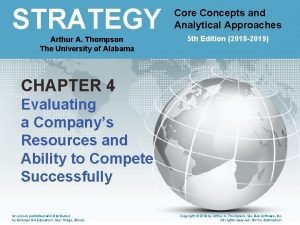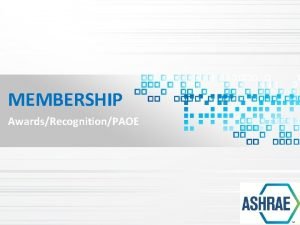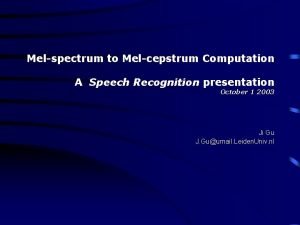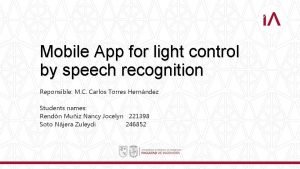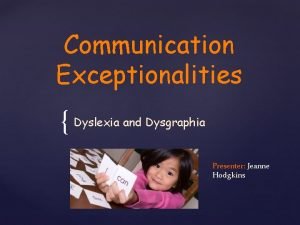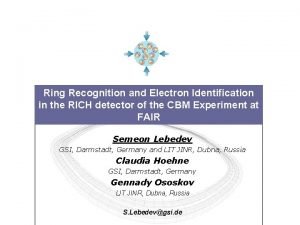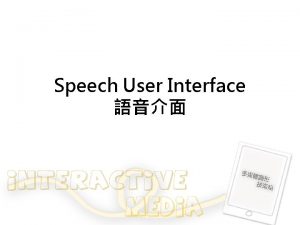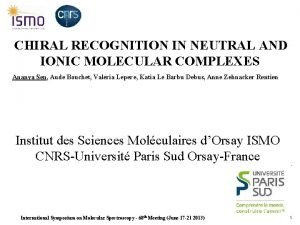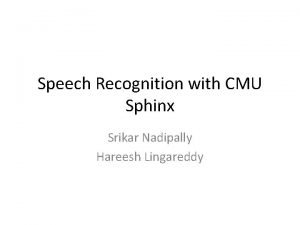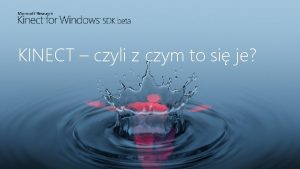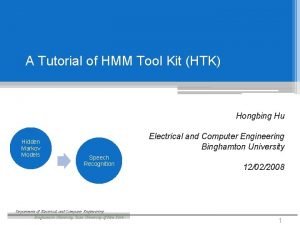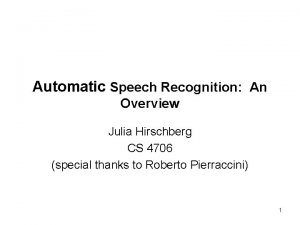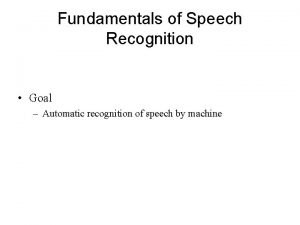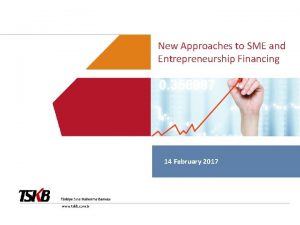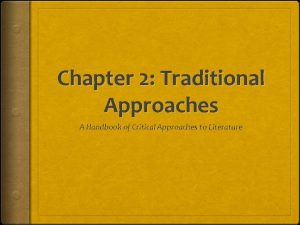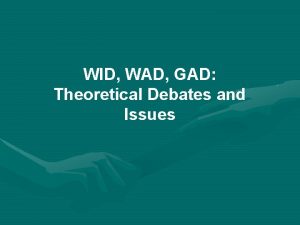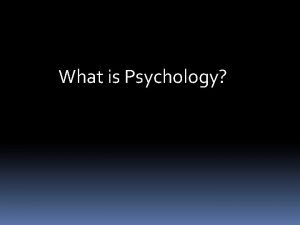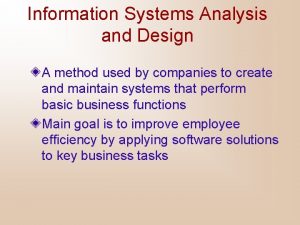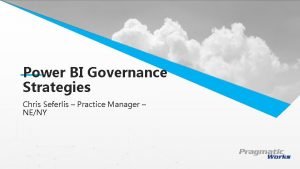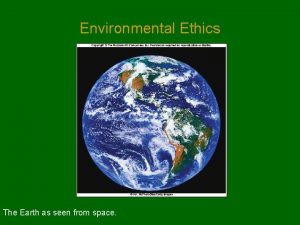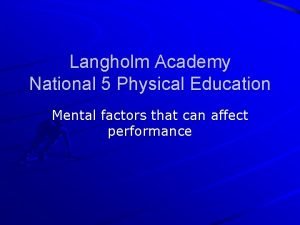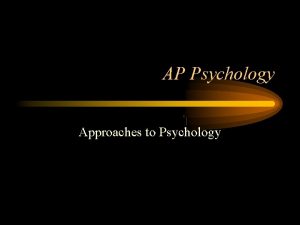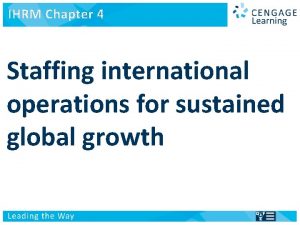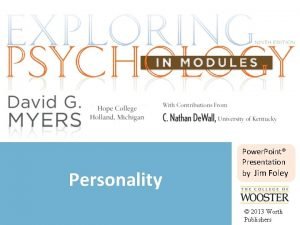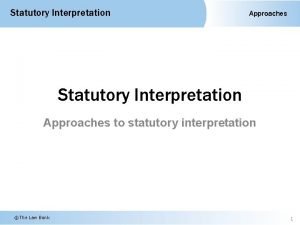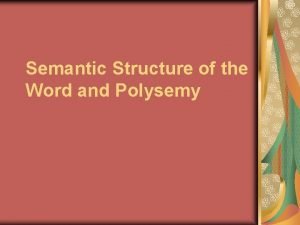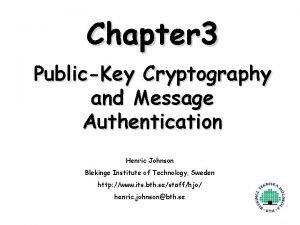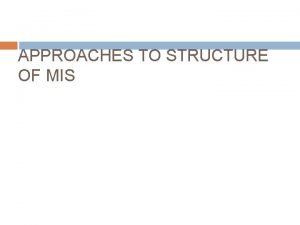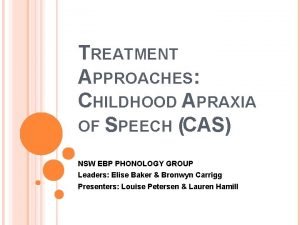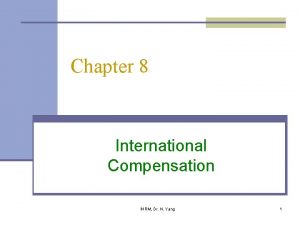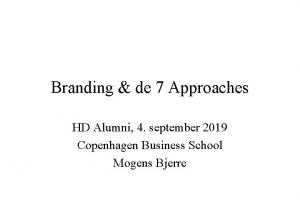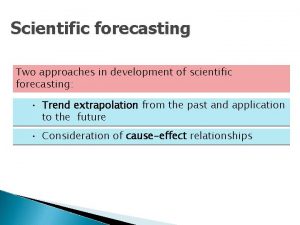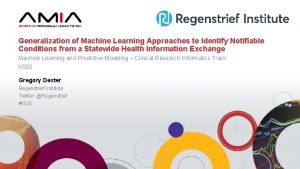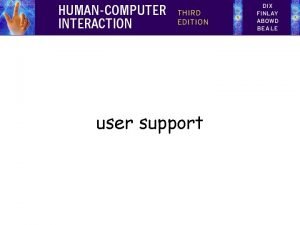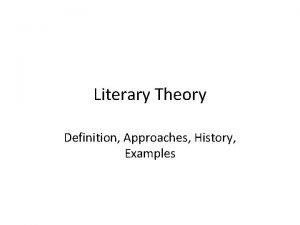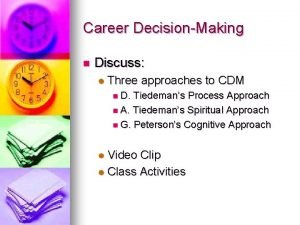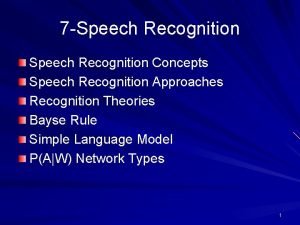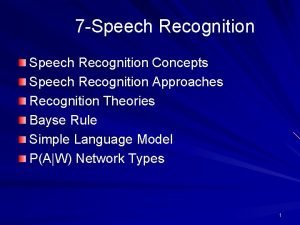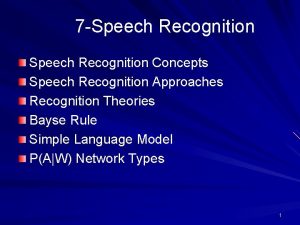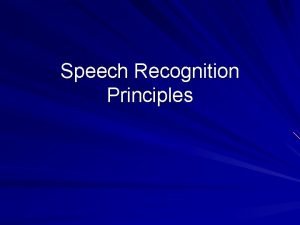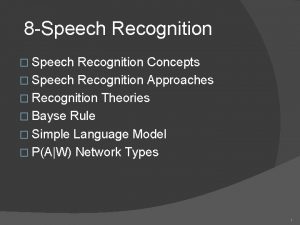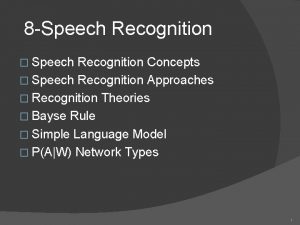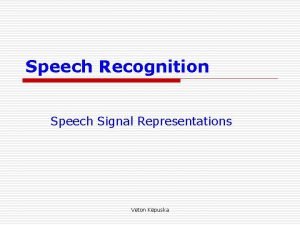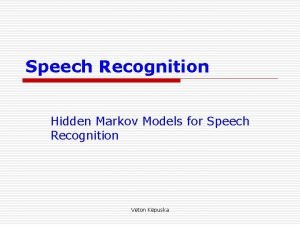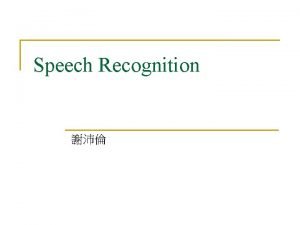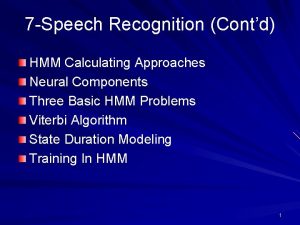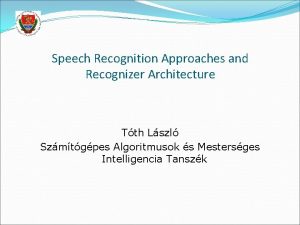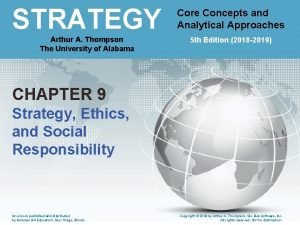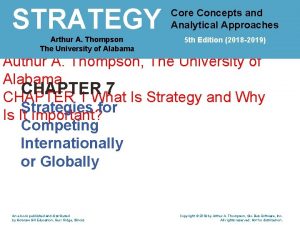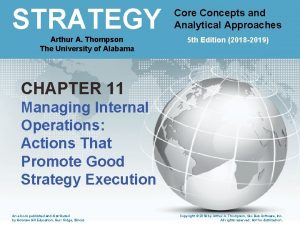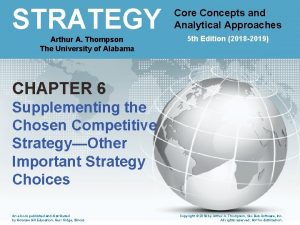7 Speech Recognition Concepts Speech Recognition Approaches Recognition




















































- Slides: 52

7 -Speech Recognition Concepts Speech Recognition Approaches Recognition Theories Bayse Rule Simple Language Model P(A|W) Network Types 1

7 -Speech Recognition (Cont’d) HMM Calculating Approaches Neural Components Three Basic HMM Problems Viterbi Algorithm State Duration Modeling Training In HMM 2

Recognition Tasks Isolated Word Recognition (IWR) Connected Word (CW) , And Continuous Speech Recognition (CSR) Speaker Dependent, Multiple Speaker, And Speaker Independent Vocabulary Size – Small <20 – Medium >100 , <1000 – Large >1000, <10000 – Very Large >10000 3

Speech Recognition Concepts Speech recognition is inverse of Speech Synthesis Text Speech Phone Processing Sequence NLP Speech Recognition Speech Processing Text Speech Understanding 4

Speech Recognition Approaches Bottom-Up Approach Top-Down Approach Blackboard Approach 5

Bottom-Up Approach Signal Processing Knowledge Sources Feature Extraction Voiced/Unvoiced/Silence Segmentation Signal Processing Sound Classification Rules Feature Extraction Phonotactic Rules Segmentation Lexical Access Language Model Segmentation Recognized Utterance 6

Top-Down Approach Inventory Word of speech Dictionary Grammar recognition units Feature Analysis Syntactic Hypo thesis Unit Matching System Lexical Hypo thesis Utterance Verifier/ Matcher Recognized Utterance Task Model Semantic Hypo thesis 7

Blackboard Approach Acoustic Processes Environmental Processes Lexical Processes Black board Semantic Processes Syntactic Processes 8

Recognition Theories Articulatory Based Recognition – Use from Articulatory system for recognition – This theory is the most successful until now Auditory Based Recognition – Use from Auditory system for recognition Hybrid Based Recognition – Is a hybrid from the above theories Motor Theory – Model the intended gesture of speaker 9

Recognition Problem We have the sequence of acoustic symbols and we want to find the words that expressed by speaker Solution : Finding the most probable of word sequence by having Acoustic symbols 10

Recognition Problem A : Acoustic Symbols W : Word Sequence we should find so that 11

Bayse Rule 12

Bayse Rule (Cont’d) 13

Simple Language Model Computing this probability is very difficult and we need a very big database. So we use from Trigram and Bigram models. 14

Simple Language Model (Cont’d) Trigram : Bigram : Monogram : 15

Simple Language Model (Cont’d) Computing Method : Number of happening W 3 after W 1 W 2 Total number of happening W 1 W 2 Ad. Hoc Method : 16

Error Production Factor Prosody (Recognition should be Prosody Independent) Noise (Noise should be prevented) Spontaneous Speech 17

P(A|W) Computing Approaches Dynamic Time Warping (DTW) Hidden Markov Model (HMM) Artificial Neural Network (ANN) Hybrid Systems 18

Dynamic Time Warping

Dynamic Time Warping

Dynamic Time Warping

Dynamic Time Warping

Dynamic Time Warping Search Limitation : - First & End Interval - Global Limitation - Local Limitation

Dynamic Time Warping Global Limitation :

Dynamic Time Warping Local Limitation :

Artificial Neural Network . . . Simple Computation Element of a Neural Network 26

Artificial Neural Network (Cont’d) Neural Network Types – Perceptron – Time Delay Neural Network Computational Element (TDNN) 27

Artificial Neural Network (Cont’d) Single Layer Perceptron. . . 28

Artificial Neural Network (Cont’d) Three Layer Perceptron. . . 29

2. 5. 4. 2 Neural Network Topologies 30

TDNN 31

2. 5. 4. 6 Neural Network Structures for Speech Recognition 32

2. 5. 4. 6 Neural Network Structures for Speech Recognition 33

Hybrid Methods Hybrid Neural Network and Matched Filter For Recognition Acoustic Output Units Speech Features Delays PATTERN CLASSIFIER 34

Neural Network Properties The system is simple, But too much iteration is needed for training Doesn’t determine a specific structure Regardless of simplicity, the results are good Training size is large, so training should be offline Accuracy is relatively good 35

Pre-processing Different preprocessing techniques are employed as the front end for speech recognition systems The choice of preprocessing method is based on the task, the noise level, the modeling tool, etc. 36

38

39

41

42






کپﺴﺘﺮﻭﻡ - ﺭﻭﺵ ﻣﻞ ﺳیگﻨﺎﻝ ﺯﻣﺎﻧی ﻓﺮیﻢ ﺑﻨﺪی |FFT|2 Mel-scaling Logarithm IDCT Cepstra Delta & Delta Cepstra Differentiator 48 Low-order coefficients



Time-Frequency analysis Short-term Fourier Transform – Standard way of frequency analysis: decompose the incoming signal into the constituent frequency components. – W(n): windowing function – N: frame length – p: step size 51

Critical band integration Related to masking phenomenon: the threshold of a sinusoid is elevated when its frequency is close to the center frequency of a narrow-band noise Frequency components within a critical band are not resolved. Auditory system interprets the signals within a critical band as a whole 52

Bark scale 53

Feature orthogonalization Spectral values in adjacent frequency channels are highly correlated The correlation results in a Gaussian model with lots of parameters: have to estimate all the elements of the covariance matrix Decorrelation is useful to improve the parameter estimation. 54
 Strategy: core concepts and analytical approaches
Strategy: core concepts and analytical approaches Occupational recognition award
Occupational recognition award Awards recognition concepts
Awards recognition concepts Awards recognition concepts
Awards recognition concepts Melspectrum
Melspectrum Speech recognition app inventor
Speech recognition app inventor Deep learning speech recognition
Deep learning speech recognition How a dyslexic person sees text
How a dyslexic person sees text Electron speech to text
Electron speech to text Dragon speech recognition
Dragon speech recognition Aude leperre
Aude leperre Cmu speech recognition
Cmu speech recognition Kinect for windows runtime
Kinect for windows runtime Htk tutorial
Htk tutorial Julia speech recognition
Julia speech recognition Speech recognition
Speech recognition Fundamentals of speech recognition
Fundamentals of speech recognition New approaches to sme financing
New approaches to sme financing Applying critical approaches to literary analysis quiz
Applying critical approaches to literary analysis quiz Data cleaning problems and current approaches
Data cleaning problems and current approaches Traditional approach in literature
Traditional approach in literature Similarities and differences of wid/wad and gad
Similarities and differences of wid/wad and gad Where do most psychologists work
Where do most psychologists work Approaches to systems development
Approaches to systems development Public health approaches
Public health approaches Power bi governanace
Power bi governanace Approaches to environmental ethics
Approaches to environmental ethics Approaches to develop mental factors higher pe
Approaches to develop mental factors higher pe The 7 approaches to psychology
The 7 approaches to psychology Determinants of staffing choices
Determinants of staffing choices Social cognitive approaches to personality
Social cognitive approaches to personality Traditional approach in literary criticism
Traditional approach in literary criticism What is managerial approach to public administration
What is managerial approach to public administration Broad approach golden rule
Broad approach golden rule Pricing approaches
Pricing approaches Types of personal selling
Types of personal selling Synchronic and diachronic approaches to polysemy
Synchronic and diachronic approaches to polysemy Working capital financing approaches
Working capital financing approaches Public key cryptography and message authentication
Public key cryptography and message authentication Elements of mis
Elements of mis Cas treatment approaches
Cas treatment approaches Going rate approach
Going rate approach 7 brand approaches
7 brand approaches What is rational detachment
What is rational detachment What are the two types of forecasting
What are the two types of forecasting What is social demand approach
What is social demand approach Learning approaches
Learning approaches User support
User support Definition of psychoanalytic criticism
Definition of psychoanalytic criticism Logging instrument approaches
Logging instrument approaches Three approaches of decision making
Three approaches of decision making Horizontal
Horizontal Approach in literary criticism
Approach in literary criticism
